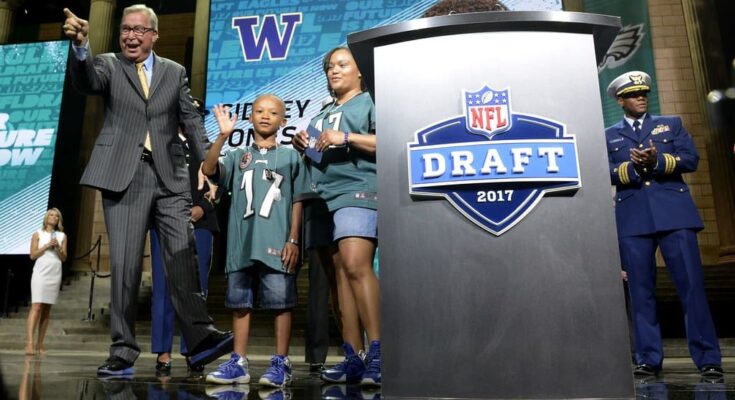Introduction: The importance of draft picks in the NFL
Welcome, football fans and draft enthusiasts! The NFL draft is a pivotal moment for teams to secure the future of their franchise. Every pick promises potential greatness, but not every selection pans out as expected. Today, we delve into the intriguing world of analyzing an unsuccessful draft pick in the NFL. Join us as we uncover valuable lessons from a misstep that can shape a team’s destiny for years.
Background on the player and team
Let’s dive into the backstory of a player and team that seemed destined for success but fell short in the NFL. Once highly touted, the player was expected to be a game-changer for their team. With impressive college stats and standout performances, anticipation was high when they were drafted.
The team had struggled in previous seasons and hoped this pick would turn their fortunes around. Fans were excited about what this new addition could bring to the roster – speed, skill, and potential impact on offense and defense.
However, as the season progressed, it became evident that things were going differently than planned. Injuries hampered the player’s performance, while off-field issues also took a toll on their game. The high expectations placed on them only added pressure to an already challenging situation.
Despite efforts from coaches and teammates to support the player, more was needed to salvage what started as a promising partnership between individual talent and team needs. Stay tuned as we unravel why this draft pick didn’t pan out like everyone had hoped…
The mistake: Why the pick did not live up to expectations
Every NFL team hopes their draft picks will blossom into star players who can lead the team to victory. However, sometimes things go differently than planned, and a promising pick needs to meet expectations. One such case that stands out is when Team Y drafted Player X with high hopes but failed to impact the field significantly.
The mistake of this pick not living up to expectations can be attributed to various factors. Injuries may have hindered the player’s performance, or perhaps they struggled to adjust to the speed and complexity of the NFL game. Off-field issues could have also played a role in their underwhelming performance.
Despite rigorous scouting processes and evaluations, some players need to translate their potential into success at the professional level. This serves as a reminder that drafting players involves inherent risks and uncertainties – no matter how talented they seem.
Teams must learn from these mistakes by constantly refining their scouting methods, prioritizing character assessments alongside physical abilities, and preparing for unexpected outcomes when selecting future draft picks. The lessons learned from past errors should shape future decisions to minimize risks and maximize opportunities for success on draft day.
Factors that contributed to the failure
When analyzing the factors that contributed to the failure of a draft pick in the NFL, it’s essential to consider various elements that played a role in the player not meeting expectations. One significant aspect could be injuries – whether pre-existing conditions or new ones acquired during gameplay can significantly impact a player’s performance and development. Another factor to consider is fit within the team’s system – sometimes, a talented player may not mesh well with their assigned role or coaching style, leading to underperformance on the field. Additionally, off-field issues such as personal struggles or lack of discipline can heavily influence a player’s success in the league. External pressures like media scrutiny or fan expectations can weigh heavily on young athletes trying to prove themselves professionally.
Lessons learned for future draft picks
As teams evaluate their draft strategies, reflecting on past mistakes and extracting valuable lessons is crucial. One key takeaway is the importance of thorough scouting and analysis before selecting. Teams should prioritize character assessment and physical skills to ensure a well-rounded pick.
Additionally, considering how a player fits into the team’s existing system and culture can significantly impact their success. Focusing on individual talent and how that talent complements the overall team dynamic is essential.
Moreover, understanding the potential risks of drafting certain players can help mitigate future disappointments. When making decisions, teams must weigh factors like injury history, work ethic, and off-field behavior.
Learning from past missteps can lead to more informed choices in future drafts and increase the likelihood of selecting impactful players who contribute positively both on and off the field.
Impact on the team and their strategy moving forward
The unsuccessful draft pick significantly impacted the team’s performance and overall strategy. It affected their immediate season and raised questions about their scouting process and decision-making. The team was forced to reevaluate its approach to player evaluation, emphasizing the need for thorough research and analysis before making future draft selections.
When evaluating prospects, the team will likely emphasize character assessments, injury histories, and fit within their system. They may also seek input from a broader range of sources to ensure they make well-informed decisions. This experience has highlighted the importance of learning from past mistakes and utilizing them as opportunities for growth and improvement in future drafts.
As they move forward, the team will be more cautious in their selections, prioritizing players with proven track records of success both on and off the field. Acknowledging this misstep and adjusting their approach accordingly, they aim to strengthen their roster for sustained success in upcoming seasons.
Conclusion: The value of learning from mistakes in the NFL draft
As we navigate the unpredictable waters of the NFL draft, it becomes evident that learning from past mistakes is crucial to success. Each misstep provides an opportunity for growth and improvement in future selections. Teams can refine their strategies and decision-making processes by analyzing what went wrong with specific picks.
The value of recognizing errors lies in avoiding similar blunders and in harnessing valuable insights to propel toward better outcomes. Embracing failures as learning opportunities fosters a culture of continuous improvement within organizations.
In the high-stakes world of professional football, adapting and evolving based on past experiences can make all the difference between mediocrity and excellence. Teams that understand this concept are better equipped to build competitive rosters capable of achieving lasting success.
By acknowledging mistakes openly and using them as stepping stones for growth, teams set themselves up for long-term prosperity in an ever-evolving landscape like the NFL draft.
FAQs,
Q: How common are unsuccessful draft picks in the NFL?
A: Unsuccessful draft picks happen more often than teams would like to admit. It’s a high-stakes game of talent evaluation, and only some picks will pan out as expected.
Q: Can teams recover from a failed draft pick?
A: Absolutely. While a failed draft pick can set a team back, organizations must learn from their mistakes and adjust their scouting and drafting strategies.
Q: What role does hindsight play in evaluating draft picks?
A: Hindsight is 20/20, but it can be a valuable tool for understanding where things went wrong with a particular pick. Analyzing past decisions can help teams make better choices in the future.
As we’ve seen from analyzing an unsuccessful draft pick in the NFL, learning from mistakes is crucial for long-term success in the league. Teams must be willing to reflect on what went wrong, identify critical factors that led to the failure, and use those insights to improve their drafting process going forward. By acknowledging missteps and making strategic adjustments, teams can position themselves for tremendous success in future drafts.




